Bennemann K.H., Ketterson J.B. Superconductivity: Volume 1: Conventional and Unconventional Superconductors; Volume 2: Novel Superconductors
Подождите немного. Документ загружается.


13 Unconventional Superconductivity in Novel Materials 681
∝
1−a
T
T
0
n
where |a|≈1andn ≈ 1−1.5;
(13.24)
C
T
∝ −
1
T
0
ln
T
T
0
or T
−1+
( ≈ 0.7−0.8);
(13.25)
∝
1−
T
T
0
n
, with n ≈ 0.5 ,
∝ −ln
T
T
0
,
or
∝ T
−1+
( ≈ 0.7−0.8) ;
(13.26)
(!, T) scales as
!
T
. (13.27)
In several of these systems, the scaling temperature
T
0
can be identified with the Kondo temperature T
K
.
The characteristic NFL temperature dependences
were first established from studies of chemically sub-
stituted f -electron materials as Y
1−x
U
x
Pd
3
[278,285],
UCu
5−x
Pd
x
[286, 287], and CeCu
6−x
Au
x
[288, 289],
but more recently have been found in stoichiomet-
ric compounds at ambient pressure (e.g., YbRh
2
Si
2
[290]) and under applied pressure (e.g., CeIn
3
[150],
CePd
2
Si
2
[291]). These experiments suggest that dif-
ferent mechanisms may be responsible for the NFL
behavior observed in these f -electron materials.
Several NFL models with distinct origins have been
proposed and can be grouped into three main cate-
gories: (i) single-ion models based on a multichannel
Kondo effect, (ii) disorder-driven NFL models, and
(iii) models involving quantum fluctuations of an
order parameter at a second-order T =0K phase
transition (QCP) Various theoretical models have
been proposed based onsingle-ion physics involving
an unconventional Kondo effect, of either magnetic
or electric (quadrupolar) origin [276, 292–295]. In
these multichannel Kondo models, the magnetic
(quadrupolar) moments are over-compensated by
a number of channels of conduction electrons due
to additional orbital (spin) degrees of freedom, giv-
ing rise to power-law or logarithmic temperature
dependences of the physical properties at low tem-
peratures. Theoretical models which incorporate
the effects of disorder include the Kondo disorder
model [296–298], in which a distribution of Kondo
temperatures T
K
due to chemical disorder with finite
weight at T
K
= 0 K leads to NFL properties, and
an inhomogeneous Griffiths–McCoy phase [299],
which consists of magnetic clusters in a paramag-
netic phase formed as a result of the competition
between the Kondo effect and the Ruderman–Kittel–
Kasuya–Yosida (RKKY) interaction in the presence
of magnetic anisotropy and disorder.
The critical behavior near a quantum critical
point has been considered by a number of investi-
gators [220–222,300–304]. Hertz [300] and later Mil-
lis [223,301] studied the fluctuations of an order pa-
rameternearaT = 0 K second order phase transition
using renormalization techniques. They found that
the critical behavior is determined by both spatial
and temporal fluctuations in an effective dimension
d
eff
= d + z,whered is the spatial dimension and
z is the dynamical exponent. The physical proper-
ties predicted by the Hertz/Millis theory including
(T), (T), C(T)/T and the dependence of the or-
dering temperature on the control parameter ı are
listed in Table 13.5. Similar results were obtained by
Moriya [220,221] with a self consistent renormaliza-
tion group model of spin fluctuations in weak itiner-
ant magnetic systems and also by a spin fluctuation
theory by Lonzarich and coworkers [222]. A recent
paper by Si examines the effect of non-Gaussian fluc-
tuations near aquantumcriticalpoint,andsuggestsa
model in whichtheKondo temperature is suppressed
to zero at the same point as the second order phase
transition, but from the opposite side of the phase
diagram [305].
Table 13.5.Spin-fluctuation theory predictions for the tem-
perature dependences of the resistivity and specific heat
divided by temperature C/T, and the dependence of the
magnetic ordering temperature T
M
on the control parame-
ter ı (pressure or carrier concentration) for 3D and 2D fer-
romagnetic (FM) and antiferromagnetic (AFM) spin fluc-
tuations
3D FM 3D AFM 2D FM 2D AFM
T
5/3
T
3/2
T
4/3
T
C/T −ln(T/T
0
)
0
− ˇT
1/2
T
−1/3
−ln(T/T
0
)
T
M
(ı − ı
c
)
3/4
(ı − ı
c
)
2/3
ı − ı
c
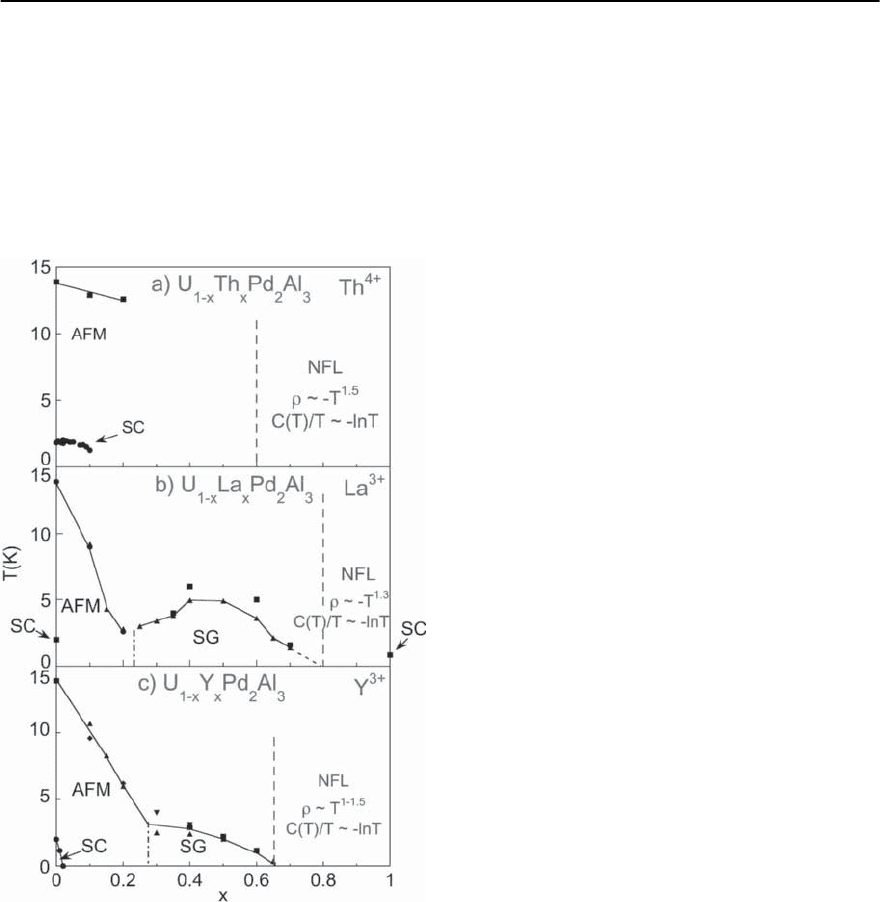
682 M.B. Maple et al.
In recent years, non-Fermi liquid behavior has
also been observed in three systems that are based
on UPd
2
Al
3
(discussed in Sect.13.3.4):U
1−x
M
x
Pd
2
Al
3
for M=Th, La, and Y. The magnetic phase diagrams
of these three systems are shown in Fig. 13.43. It
is remarkable that although these three systems
have the same parent compound, the phase dia-
gram of U
1−x
Th
x
Pd
2
Al
3
is quite different from those
of U
1−x
La
x
Pd
2
Al
3
and U
1−x
Y
x
Pd
2
Al
3
.BoththeAFM
Fig. 13.43. Temperature–M concentration (T–x) phase di-
agrams of the U
1−x
M
x
Pd
2
Al
3
(M =Th,La,Y) systems.Re-
gions of antiferromagnetic order (AFM), spin glass freez-
ing (SG), superconductivity (SC) and non-Fermi liquid be-
havior (NFL) determined from measurements of the spe-
cific heat C, magnetic susceptibility , and electrical resis-
tivity as a function of temperature T are indicated in the
T − x plane. The temperature dependences of and C/T
observed in the NFL regions are indicated in the figure,
after [306]
order and superconductivity are only slightly sup-
pressed with Th substitution (Fig.13.43a) at x =0.2,
and the system crosses over to an NFL regime at
x ≈ 0.6. The NFL properties of U
1−x
Th
x
Pd
2
Al
3
at
low temperatures scale with U concentration indi-
cating the NFL behavior is associated with single-ion
physics such as an unconventional Kondo effect.
In the U
1−x
Y
x
Pd
2
Al
3
system, the antiferromag-
netismand superconductivity are rapidly suppressed
with Y substitution (Fig. 13.43c). Similar behavior
is found for U
1−x
La
x
Pd
2
Al
3
(Fig. 13.43b). The N´eel
temperature decreases from T
N
≈ 14 K in UPd
2
Al
3
to T
N
≈ 7Kbyx =0.2, after which spin glass behav-
ior is observed at T
SG
≈ 1 K. The spin glass transi-
tion is no longer observed at a critical concentra-
tion x
c
≈ 0.7 near the concentration where the NFL
behavior occurs [307]. It appears that T
SG
vanishes
nearly linearly with x as x → x
c
. These results sug-
gest that the NFL behavior in this system is associ-
ated with fluctuationsof a magnetic order parameter
above the spin glass freezing transition at T =0K.
An example of the NFL behavior observed in these
systems is shown in Fig. 13.44 for a U
1−x
Y
x
Pd
2
Al
3
sample with a composition (x =0.8) close to that
of the QCP at x
c
≈ 0.7. The physical properties of
U
0.2
Y
0.8
Pd
2
Al
3
at low temperatures have the follow-
ing T-dependences: ∝ T, C/T ∝ (or T
n
with
n =0.2), and ∝ [1 − (T/T
0
)]
1/2
.
Although the magnetic phase diagram of
U
1−x
La
x
Pd
2
Al
3
is similar to that of U
1−x
Y
x
Pd
2
Al
3
,
the non-Fermi liquid behavior is close to that of
U
1−x
Th
x
Pd
2
Al
3
.Thissuggeststhatdisorderfromlo-
cal expansion of the lattice by the larger Th and
La ions could be driving the NFL behavior in these
compounds.SubstitutionwithY leaves the lattice un-
changed [306].
Non-Fermi liquid behavior has also been found
in the vicinity of a ferromagnetic quantum criti-
cal point in systems such as Th
1−x
U
x
Cu
2
Si
2
[311]
and URu
2−x
Re
x
Si
2
[310]. The substitution of Re
or Tc for Ru in the heavy-fermion superconductor
URu
2
Si
2
has been found to suppress both hidden or-
der (HO) [312] and superconductivity and induce
ferromagnetism (FM) [308,309].The superconduct-
ing transition temperature T
c
of URu
2−x
Re
x
Si
2
de-
creases rapidly from T
c
=1.5Kat x =0to below
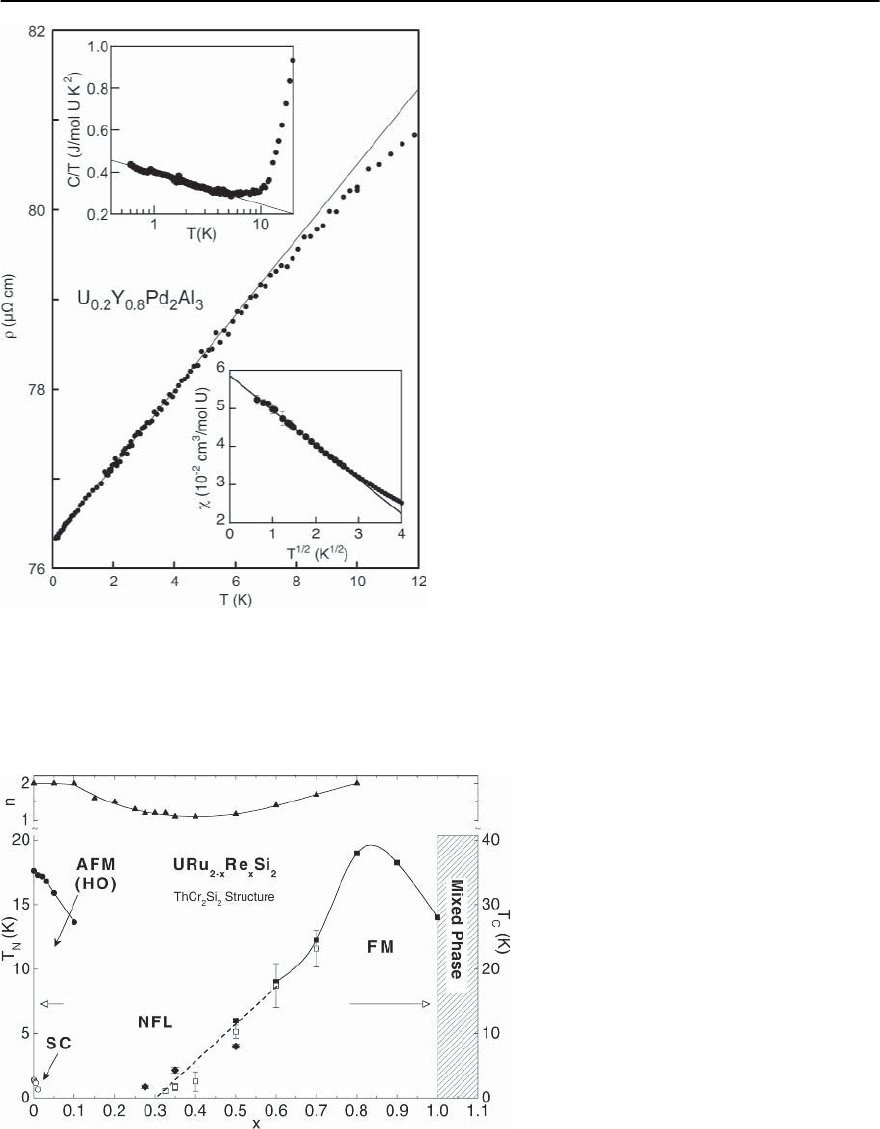
13 Unconventional Superconductivity in Novel Materials 683
Fig. 13.44. Electrical resistivity vs T, specific heat divided
by temperature, C/T,vslogT(upper inset), and magnetic
susceptibility vs T
1/2
(lower inset)forU
0.2
Y
0.8
Pd
2
Al
3
,af-
ter [307]
200 mK at x =0.01, while the N`eel temperature T
N
associated with the formation of the small-moment
(∼ 0.03
B
/U atom) hidden order phase (often as-
sociated with antiferromagnetism or a spin den-
sity wave) at 17.5 K decreases less rapidly with x
and appears to vanish by x =0.15 as shown in the
T − x phase diagram in Fig.13.45. Ferromagnetic or-
der occurs in the concentration range 0.3 ≤ x ≤ 1.0
where the Curie temperature
C
, saturation moment
sat
, and electronic specific heat coefficient ,ex-
hibit maxima at x =0.8of38K,0.44
B
/U atom,
and 160 mJ/mol K
2
[308], respectively, as displayed
in Fig. 13.46. Magnetic measurements indicate that
the suppression of FM order occurs at x
FM
c
=0.3.For
samples close to where features associated with the
hidden order phase can no longer be resolved and
the FM critical point (x
FM
c
=0.3) with Re concen-
trations 0.15 < x ≤ 0.6,the non-Fermi liquidbehav-
ior is characterized by C/T ∝ −lnT and (T) ∝ T
n
with 1 ≤ n < 2 at low temperatures [310].Therefore,
it appears that the NFL behavior persists well into
the ferromagnetic state.
NFL behavior is observed in a wide range of
CeMIn
5
(M = Co, Rh, Ir) compounds as discussed
previously. In addition to the NFL behavior found
in stoichiometric CeCoIn
5
, studies of the chem-
ically substituted systems Ce
1−x
(La,Y)
x
RhIn
5
and
Ce
1−x
La
x
CoIn
5
have revealed logarithmic or power-
law divergences of the specific heat and magnetic
Fig. 13.45. Magnetic phase diagram of the
URu
2−x
Re
x
Si
2
system showing the hidden or-
der (HO, filled circles), superconducting (SC,
open circles), and ferromagnetic (FM, squares)
regions. The power-law exponent of the electri-
cal resistivity,n,isshowninthetop part.Some
data are taken from [308,309],after [310]
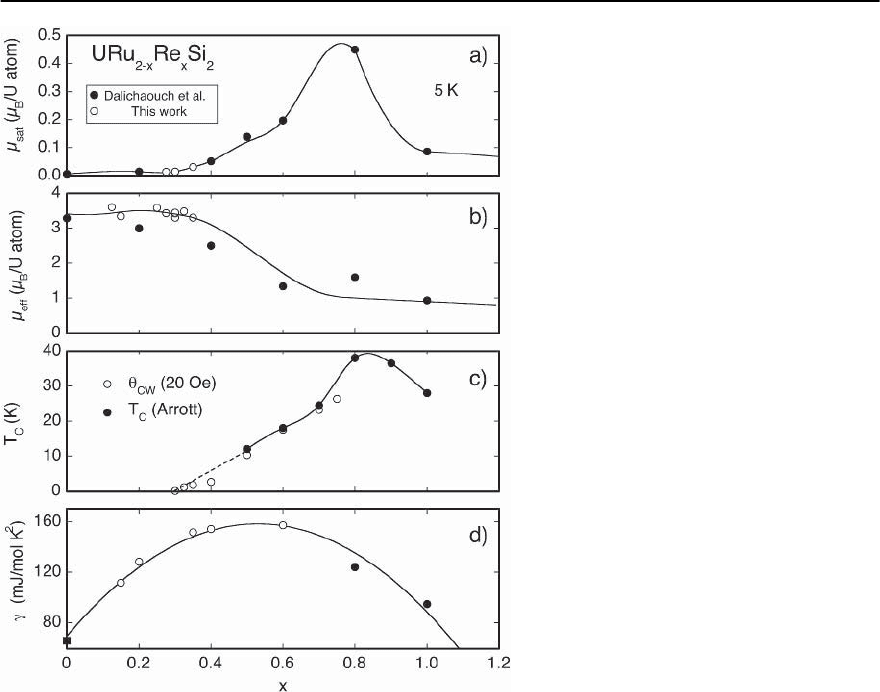
684 M.B. Maple et al.
Fig. 13.46. Physical properties of URu
2−x
Re
x
Si
2
vs Re concentration x. (a) Saturation moment
sat
(at 5 K); (b) effective moment
eff
; (c) Curie
temperature T
C
and Curie–Weiss temperature
CW
;and(d) electronic specific heat coefficient
(at 1 K). The filled circles are from [308].Data
for x = 0 from [163].The lines are guides to the
eye, after [310]
susceptibility once the superconductivity or antifer-
romagnetism in the parent compounds is suppressed
[313–315]. In Ce
1−x
(La,Y)
x
RhIn
5
compounds, addi-
tional humps in the specific heat and peaks in the
magnetic susceptibility are observed that coexist
with NFL behavior and decrease with increasing x.
These features can described by the Ce
3+
J =5/2
Hund’s rule multiplet being split by a tetragonal
CEF [313]. The humps in the specific heat have also
been attributed to short-range 2D antiferromagnetic
correlations. [314,316].
An interesting new theory for NFL behavior has
arisen out of studies of the CeMIn
5
compounds.
In this model, the specific heat and magnetization
are decomposed into two components: a Kondo-gas
part which obeys the single-ion Kondo model, as-
sociated with the coupling between Ce local mo-
ments and conduction electrons,and a Kondo-liquid
portion, resulting from intersite coupling between
the Ce moments. This model was proposed for the
Ce
1−x
La
x
CoIn
5
system [317], and can also be applied
to the Ce
1−x
Y
x
RhIn
5
system [318]. For these two sys-
tems, the fraction f
K
of electrons participating in the
single-ion Kondo effect increases roughly linearly as
afunctionofx until it saturates at x =0.9, at which
point the Kondo-liquid portion goes to zero and the
system entirely obeys the single-ion Kondo model.
The fraction f
K
also varies as a function of temper-
ature. For pure CeCoIn
5
, the Kondo gas condenses
into a Kondo liquid below T
∗
∼ 45 K, resulting in a
sudden downturn in the electrical resistivity or “co-
herence shoulder”. This model provides an intrigu-
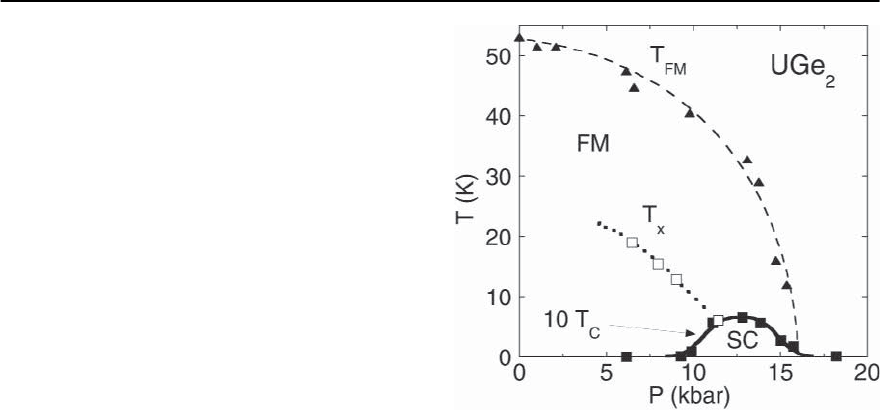
13 Unconventional Superconductivity in Novel Materials 685
ing new possibility for the origin of NFL behavior,at
least in the CeMIn
5
compounds, and its applicability
to other systems needs to be investigated.
13.3.7 Magnetically Ordered H eavy-Fermion
Superconductors
In addition to the antiferromagnetic heavy-fermion
superconductors such as CeIn
3
and CePd
2
Si
2
dis-
cussed in Sect. 13.3.5, several ferromagnetic heavy-
fermion superconductors have been discovered re-
cently and are described in the following.
UGe
2
Superconductivity under pressure was observed by
Saxena et al. in single crystal specimens of the fer-
romagnetic (FM) compound UGe
2
within the ferro-
magnetic phase up to the critical pressure P
c
≈ 16
kbar where the ferromagnetism vanishes [3]. Shown
in Fig. 13.47 is the T − P phase diagram for single
crystals of UGe
2
[3]. The Curie temperature T
FM
de-
creases from 53 K at ambient pressure to ≈ 12 K at
P = 15 kbar, above which the FM transition can no
longer be determined from the (T) curves,suggest-
ing a first-order-like transition. A small feature in
the resistivity curves is observed at applied pres-
sures P < 13 kbar, perhaps related to a spin den-
sity wave (SDW) or charge density wave (CDW), and
is denoted in Fig. 13.47 as T
x
[165,201]. Supercon-
ductivity is confined to a narrow pressure region
10 kbar ≤ P < 16 kbar reaching a maximum value
of T
c
=0.7KatP
x
= 13 kbar where features associ-
ated with the possible SDW/CDW can no longer be
observed [3] (the phase diagram of polycrystalline
UGe
2
samples, discussed below, is similar [201]). No
superconductivity is observed at or above P
c
,indi-
cating that the ferromagnetism and superconductiv-
ity areintimately related.Recent magnetizationmea-
surementsunder pressure confirm the first-order FM
phase transition at P
c
and reveal that the transition
at T
x
is also first-order [319].
It has been suggested that UGe
2
is a p-wave su-
perconductor, in which the superconducting elec-
trons do not suffer from the pair-breaking inter-
action caused by the large internal magnetic field,
Fig. 13.47. Temperature-pressure T − P phase diagram of
UGe
2
. T
FM
denotes the Curie temperature; T
c
denotes the
superconducting transition (the T
c
values are scaled by a
factorof 10 forclarity; T
x
denotes the feature in the (P, T)
curves possibly due to a SDW/CDW transition. The solid
and dashed lines are guides to the eye, after [3,165]
since the mean free path l ∼ 1500 Å is much larger
than the superconducting coherence length
0
∼
130 − 200 Å [3,202]. Specific heat experiments un-
der applied pressure reveal a finite value of C/T as
T → 0 K,which is consistent with the superconduct-
ing gap vanishing at lines or points on the Fermi
surface [166,202]. In addition, neutron diffraction
measurements yield no evidence of a change in the
magnetic moment upon entering the superconduct-
ing state, consistent with p-wave superconductiv-
ity [165].Spin-tripletsuperconductivitymediated by
coupled SDW/CDW spin fluctuations has been put
forth in recent theoretical work by Watanabe and
Miyake [320]. This theory can explain the anoma-
lous reentrant behavior observed in upper critical
field measurements along the a-axis of UGe
2
and the
anisotropy of H
c2
[165]; however,neutrondiffraction
measurements do not reveal any static order asso-
ciated with a SDW/CDW. While these results can be
explained within a spin-triplet scenario of supercon-
ductivity,an investigation on polycrystalline samples
of UGe
2
with electron mean free paths of the order
of the superconducting coherence length, discussed
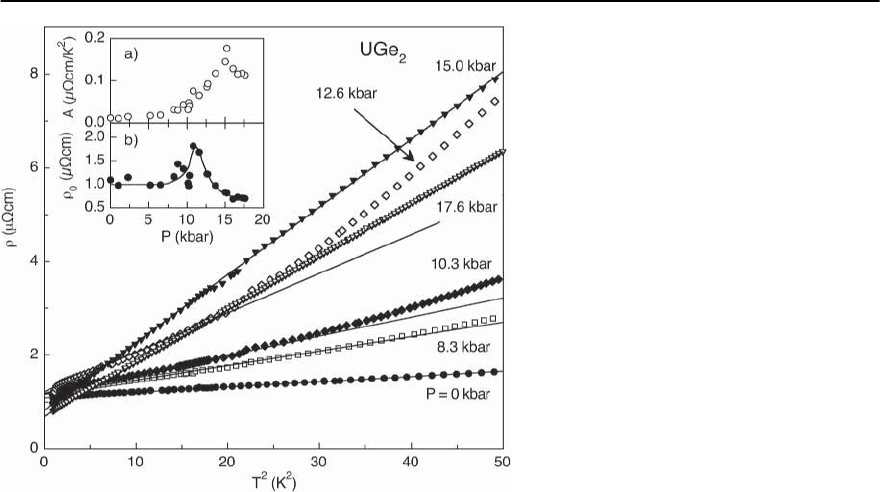
686 M.B. Maple et al.
Fig. 13.48. Electrical resistivity vs T
2
for UGe
2
at various applied pressures P.Thelines are fits
to the data of the form =
0
+ AT
2
Inset (a):
Coefficient of the T
2
term of (T), A,vsP.Inset
(b): Residual resistivity
0
vs P, after [201]
below, indicates that the superconductivity in UGe
2
may have s-wave character [201].
It is widely believed that p-wave superconductors
arequitesensitive tononmagnetic impurities,result-
ing in the suppression of superconductivity when
l ≈
0
,wherel is the electron mean free path and
0
is the superconducting coherence length. Two of
the leading candidates for p-wave superconductiv-
ity are Sr
2
RuO
4
[321,322] and UPt
3
[323,324].When
the ratio l/
0
∼ 1, T
c
is completely suppressed for
Sr
2
RuO
4
[325] and decreases by 15 % for UPt
3
[324].
However, in UGe
2
superconductivity was observed
in some polycrystalline samples with residual resis-
tivities
0
as high as 3 ܤcm, corresponding to a
mean free path l ∼ 100 Å, without any apparent
diminution of T
c
. Since the superconducting coher-
ence length
0
is ∼ 130 − 200 Å [3, 202], this rep-
resents a ratio l/
0
≈ 1, considerably reduced from
the value l/
0
≈ 10 observed for the single crystal
specimens of UGe
2
. This suggests that the supercon-
ductivity observed in UGe
2
under pressure may have
s-wave character. It is noteworthy that several the-
ories have recently been proposed in which s-wave,
rather than p-wave,superconductivityispredicted to
occur in the ferromagnetic state [326–330].
In the low temperature FL-like phase, the residual
resistivity
0
and the coefficient A of the T
2
con-
tribution to the resistivity, (T)=
0
+ AT
2
,are
both strongly dependent on pressure as shown in
Fig. 13.48 for polycrystalline samples of UGe
2
and
exhibit peaks at 15 kbar and 11 kbar, respectively
(inset of Fig. 13.48). It is interesting that the maxi-
mum in
0
correlates with the broad maximum in
T
c
(P) that is centered near the same pressure. Spe-
cific heat measurements on polycrystalline samples
of UGe
2
reveal that increases with pressure up to
15 kbar [166].The increase of is consistent with the
behavior of A(P) according to the Kadowaki–Woods
relation A =1.0 × 10
−5
2
ܤ cm (molK/mJ)
2
[188].
Since T
c
of a conventional s-wave superconductorin-
creases with N(E
F
), which is proportional to ,and
is not strongly affected by potential scattering, the
correlationbetween T
c
, ,and
0
is qualitativelycon-
sistent with s-wave superconductivity.
A precedent for the macroscopic coexistence of
ferromagnetism and s-wave superconductivity is
found in the compound ErRh
4
B
4
, discussed in Sect.
13.2.3, which exhibits localized moment ferromag-
netism, in contrast to UGe
2
, which is regarded as
an itinerant ferromagnet. The compound ErRh
4
B
4
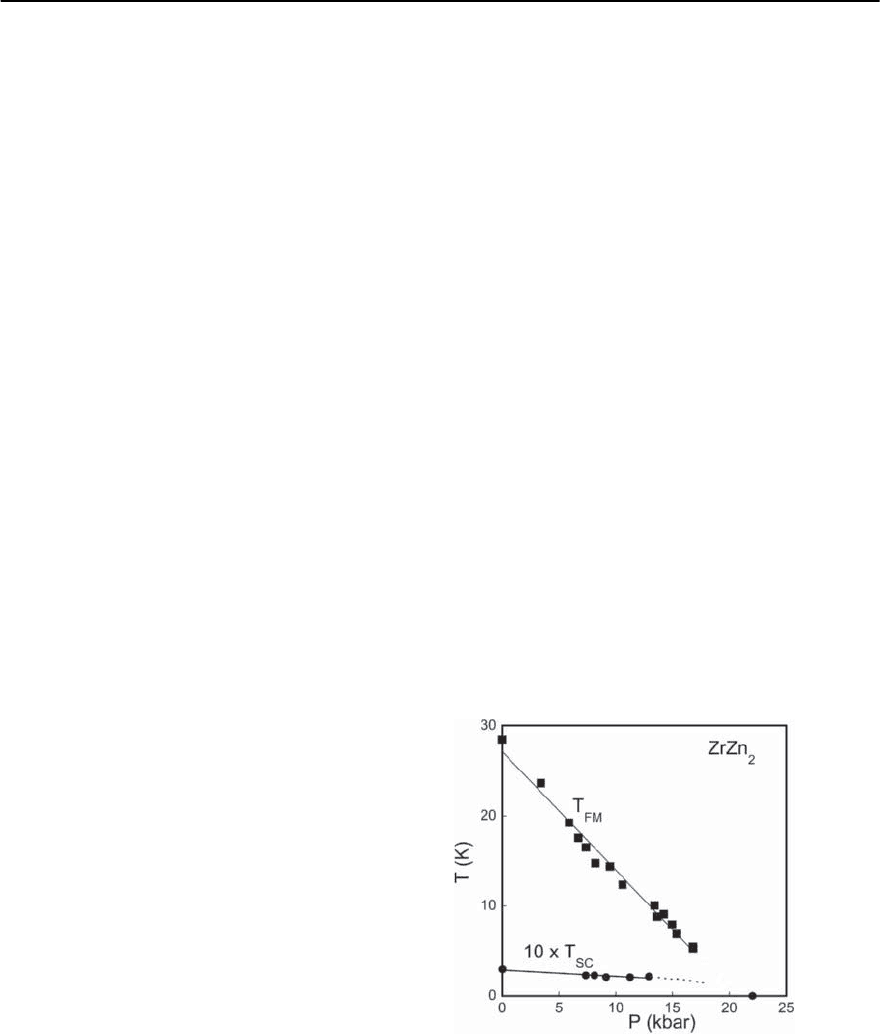
13 Unconventional Superconductivity in Novel Materials 687
becomes superconducting at a critical temperature
T
c1
≈ 8.7 K, FM at a Curie temperature T
FM
≈ 1.5
K, and normal again at a second critical temperature
T
c2
≈ 0.9 K [80]. There is evidence, based on neu-
tron scattering and specific heat measurements [84],
for the macroscopic coexistence of FM and super-
conducting regions in the temperature interval be-
tween T
c2
and
c
. Within the superconducting re-
gions between T
c2
and
c
, a sinusoidally modulated
magnetic state with a wavelength of ∼ 100 Å that co-
exists with superconductivity has been detected by
means of small angle neutron scattering measure-
ments [84]. The sinusoidally modulated magnetic
state is believed to be produced by screening of the
magnetic field associated with the ferromagnetically
aligned Er magnetic moments by the supercurrents
at long wavelengths [331].Similar behavior has been
found for the localized moment FM superconduc-
tor HoMo
6
S
8
[332]. It seems reasonable that such
an inhomogeneous FM s-wavesuperconducting state
could also exist in UGe
2
, in spite of the fact that it is
an itinerant ferromagnet.
Irrespective of whether the superconductivity in
UGe
2
is of s-wave (spin-singlet) or p-wave (spin-
triplet) variety, it appears to be strongly connected
to the ferromagnetism. For s-wave superconductiv-
ity, it seems possible that the onset of superconduc-
tivity occurs when the Curie temperature drops to
a value such that the superconductivity is no longer
suppressed by the internal field in the ferromagnet,
while near P
c
where the Curie temperature vanishes,
the superconductivity is suppressed by the ferro-
magnetic spin fluctuations. Alternatively, the longi-
tudinal spin fluctuations may actually produce pair-
ing of electrons in spin-singlet s-wave states as pro-
posed recently by Suhl [329] and developed further
by Abrikosov [330]. The competition between these
two effects could then lead to the maximum in T
c
at
a pressure below P
c
.For triplet-spin superconductiv-
ity, the superconductivity would seem to require the
presence of the ferromagnetism and be optimized
at a pressure below P
c
. Further experiments will be
required to develop an understanding of the origin
and nature of superconductivity in this remarkable
material.
Other Ferromagnetic Heavy-Fermion Superconductors
The coexistence of superconductivity and ferromag-
netism was recently reported in URhGe [109], UIr
[168] and ZrZn
2
[333]. While bulk superconductiv-
ity appears to be well established in URhGe given the
specific heat jump at T
c
[109], the situation is less
clear for UIr and ZrZn
2
. In UIr, ferromagnetism in
this material at T
FM
= 46 K is rapidly suppressed
with pressure [167] and evolves into another small-
moment ferromagnetic phase that is destroyed at
a critical pressure P
c2
= 26 kbar [168]. Near this
critical pressure, the electrical resistivity follows a
power-law T-dependence ( ∼ T
n
)withanexpo-
nent n 5/3 as expected for critical spin fluctua-
tions of a 3D ferromagnet [220] (see Table 13.5). In
addition,superconductivityis observed at T
c
=0.14
KinthevicinityofP
c2
suggesting that ferromag-
netic fluctuations may mediate the pairing in this
material. As discussed in Sect. 13.3.5, UIr is a can-
didate for spin-triplet superconductivity,despite the
lack of inversion symmetry. The large initial slope
of the upper critical field and the large value of the
T
2
coefficient of (T) indicate an enhancement of
the effective mass [168].However, the identical value
of T
c
and similar H
c2
of Ir [334] raise the possibil-
ity of filamentary superconductivity associated with
Ir in UIr; additional measurements are needed to
Fig. 13.49. Pressure-temperature phase diagram of ZrZn
2
.
T
FM
: Curie temperature; T
c
: Superconducting critical tem-
perature. The values of T
c
have been multiplied by a factor
of 10 for clarity,after [333]

688 M.B. Maple et al.
clarify the nature of superconductivity in this inter-
esting material. For ZrZn
2
, a superconducting tran-
sition at T
c
≈ 0.3 K was observed to decrease with
increasing pressure and vanish near the critical pres-
sure P
c
at which T
FM
vanishes as shown in Fig.13.49.
The absence of a superconducting anomaly in spe-
cific heat, and the occurrence of superconductivity
within the ferromagnetic state only in very pure sam-
ples suggest the possibility of a spin-triplet pairing
mechanism, although trace amounts of a supercon-
ducting impurity phase cannot be ruled out at this
point.
13.3.8 Multiple SuperconductingPhases
UPt
3
and U
1−x
Th
x
Be
13
The first direct evidence for unconventional super-
conductivity was found for the compound UPt
3
,
which displays at least three distinct supercon-
ducting phases. Multiple superconducting phases
were also found in the heavy-fermion compound
U
1−x
Th
x
Be
13
when substituted with 2 − 4 % Th, and
morerecentlyin PrOs
4
Sb
12
(discussed in Sect.13.3.9).
The appearance of multiple superconducting phases,
whichcannot beexplainedintermsof a conventional
s-wave order parameter, has prompted a flurry of in-
vestigations into these exciting compounds.
UPt
3
exhibits antiferromagnetic (AFM) order be-
low T
N
= 5 K with a very small ordered moment of
0.02
B
/U atomaligned in thebasal plane [182].Early
measurements on as-grown samples showed a single
broadsuperconducting transition in the specific heat
at 0.5 K; however, later measurements of annealed
samples revealed two peaks in the specific heat near
T
c
at temperatures T
+
c
and T
−
c
[335].The specific heat
vs temperature of a single crystal of UPt
3
is plotted
in Fig. 13.50. The double kink feature has been veri-
fied in many different crystals, and while the values
of the T
c
’s vary between samples, the kinks are al-
ways separated by about 50 mK. These data, along
with anomalies in ultrasonic attenuation [336], and
akinkinH
c2
vs T point to multiple superconducting
phases.
The superconducting phase diagram of UPt
3
de-
termined fromsound velocity measurements [337] is
shown in Fig. 13.51, where “N” indicates the normal
Fig. 13.50. Specific heat of UPt
3
in the vicinity of the super-
conductingtransition plottedas C/T vs T.Thedashed lines
represent two idealized jumps,and the solid line represents
a single jump with the same entropy, after [335]
(antiferromagnetic) state, and the three supercon-
ducting phases are labeled “A”,“B”, and “C”. The T
+
c
and T
−
c
transitions observed in the specific heat at
zerofieldcorrespondtotheN-to-AandtheA-to-B
phase transition lines. Measurements of muon spin
relaxation reveal that the transition to the B phase at
T
−
c
is accompanied by the onset of a small internal
field at 475 mK. These data might lead to the con-
clusion that the phase transition at T
−
c
just signifies
the onset of magnetic order.However,the peak in the
specific heat at the first transition is so large that it
occupies most of the Fermi surface, and there is not
enough entropy left for an equally large magnetic
transition at T
−
c
. The second transition can only be
explained in terms of a transition to a different su-
perconducting phase. Both transitions satisfy the re-
lation C/ T
c
∼ 1 indicating that heavy electrons
are responsible for the superconductivity (see [288]
for a review).
The heavy-fermion compound U
1−x
Th
x
Be
13
also
shows a rich phase diagram with multiple super-
conducting phases. The phase diagram determined
from specific heat,upper criticalfield, and ‹SR stud-
ies is shown in Fig. 13.52 where “A” and “B” indicate
the two superconducting phases [338]. As in UPt
3
,
the second superconducting transition is accompa-
nied by a transition to very small moment mag-
netism (0.001
B
/U)[339].Recent point contact spec-
troscopy measurements on UPt
3
[340] are consistent

13 Unconventional Superconductivity in Novel Materials 689
0
0.5
1
1.5
2
2.5
0 100 200 300 400 500
)alseT( H
T (mK)
H
c
UPt
3
C
B
A
N
0
0.5
1
1.5
2
0 100 200 300 400 500
)alseT( H
T (mK)
H || c
C
B
A
N
Fig. 13.51. Superconducting phase diagram of UPt
3
deter-
mined from ultrasonic velocity measurements. [337]. The
data points delineate the second-order phase transition
lines between three superconducting phases “A”,“B”, and
“C”, and the normal state “N”,after [337]
Fig. 13.52. Phase diagram of U
1−x
Th
x
Be
13
, after [338]
with line nodes in the ab plane and point nodes along
thec-axis,whileNMR measurements of both systems
show T
3
temperature dependence below T
c
,indicat-
ing lines of nodes.
Measurements of T
c
(P)ontheU
1−x
Th
x
Be
13
sys-
tem are displayed in Fig. 13.53 as isobars of T
c
vs x
for 0 ≤ x ≤ 12 kbar [341]. Two different types of
behavior are present for each pressure, separated by
Fig. 13.53. Isobars of the superconducting critical temper-
ature T
c
vs x for U
1−x
Th
x
Be
13
between 0 and 12 kbar, af-
ter [341]
the minimum in T
c
(x)atx
min
.Forx < x
min
,amono-
tonic decrease of T
c
(x) is observed as the pressure
increases, and the magnitude of the slope dT
c
/dP
also becomes larger with increasing x.Forx > x
min
,
an abrupt increase of T
c
occurs with a maximum
and subsequent decrease for higher x. The position
of this maximum is pressure dependent, moving to
higher concentration as P increases. It is tempting
to infer from the T
c
(x) curves the existence of two
distinct superconducting phases, one in the regions
0 ≤ x ≤ x
min
(A phase) and the other at x > x
min
(B phase), where x
min
is a function of pressure. The
way the T
c
(x) curves evolve with pressure suggests
that the T
c
(x) phase boundary for x < x
min
extends
approximately linearly with the same slope to the re-
gion x > x
min
.
A variety of theories have been advanced to ex-
plain the unconventional superconductivity in UPt
3

690 M.B. Maple et al.
and U
1−x
Th
x
Be
13
. These theories have been exten-
sively reviewed in [342–344]. For UPt
3
,mostofthe
data points to a spin singlet [345] or spin triplet
[344,346] complex (two component) superconduct-
ing order parameter [342]. Another possibility that
is difficult to rule out is the presence of two differ-
ent superconducting phases with different symme-
tries that happen to be nearly degenerate in tem-
perature [347,348]. The small moment magnetism
in the“B” superconducting states could be explained
by a superconducting order parameter that breaks
time reversal symmetry.On the other hand, the mag-
netism could simply result from the onset of a spin
density wave. The coupling between superconductiv-
ity and magnetism is a key issue that still needs to be
resolved.
InthecaseofU
1−x
Th
x
Be
13
,there are three second-
order phase transitions thatmeet at a tricritical point,
which is theoretically not allowed [349].This implies
the existence of other phase transition lines.An addi-
tional phase transition has indeed been observed by
assuming that Th substitution is equivalent to pres-
sure,andmeasuring specific heat as a functionof ap-
plied pressure for a sample with x = 0.019.One of the
more popular models for U
1−x
Th
x
Be
13
[343,350] as-
sumes multiple degenerate superconducting phases
with different symmetries, as was mentioned for
UPt
3
. The pure UBe
13
compound is assumed to have
a d-wave symmetry and an s-wave phase with a lower
T
c
.Thed-wave phase is suppressed with Th doping
more rapidly than the s-wave phase, causing the two
transition lines to cross. Thus for intermediate Th
concentrations there is a pure s-wave phase at high
temperatures and a mixed s − d phase at lower tem-
peratures.
PrOs
4
Sb
12
Recently, superconductivity was observed in the
filled skutterudite compound PrOs
4
Sb
12
at T
c
=1.85
K [123, 135]. The superconductivity evidently in-
volves heavy-fermion quasiparticles with an effec-
tive mass m
∗
≈ 50 m
e
, as inferred from the normal-
state electronic specific heat coefficient ,thejump
in the specific heat at T
c
, and the slope of the up-
per critical field near T
c
. This compound appears
to be the first example of a Pr-based heavy-fermion
superconductor.When this material was first discov-
ered, the quadrupolar Kondo effect, which involves
screening of Pr
3+
electric quadrupole moments of a
nonmagnetic
3
doublet ground state in the CEF by
the charges of the conduction electrons [276, 277],
analogous to the screening of the magnetic dipole
moments of paramagnetic ions by conduction elec-
tronspinsthatoccursinthemagneticKondoeffect,
was put forth as a possible scenario for the heavy-
fermion behavior [123,135]. Another scenario could
involve virtual excitations from either a
1
singlet or
a
3
nonmagnetic doublet ground state to a low lying
(∼10 K)
5
triplet state [351].
Evidence for the heavy-fermion behavior in
PrOs
4
Sb
12
was provided by the magnitude of the
superconducting specific heat jump on a pressed
pellet of single crystals as displayed in the inset of
Fig. 13.54.(TheC(T) data havebeen corrected for ex-
cess Sb derived from the molten Sb flux in which the
crystals were grown.) An equal entropy construction,
in which the entropy is conserved just above and be-
low T
c
,yieldsC/T
c
= 632 mJ/mol K
2
.Thevalueof
the electronicspecific heatcoefficientfromthe weak-
coupling BCS prediction (C/ T
c
=1.43) is ≈ 440
mJ/mol K
2
. In the normal state, the specific heat can
be described by C(T)= T + ˇT
3
+ C
Sch
(T), where
T and ˇT
3
areelectronicand phonon contributions,
respectively, and C
Sch
(T) is a Schottky anomaly for a
two level system consisting of a doublet ground state
and a triplet excited state at an energy above the
ground state. The best fit of this expression to the
data yields the values = 607 mJ/mol K
2
, ˇ =3.95
mJ/mol K
4
(corresponding to a Debye temperature
D
= 203 K), and =7.15 K.
A number of measurements on PrOs
4
Sb
12
pro-
vide evidence for the formation of a nonmagnetic
1
ground state due to splitting of the J =4 mul-
tiplet of Pr in a cubic crystalline electric field.
1
In
this scenario, hybridization between the
1
and ex-
1
In O
h
symmetry, the J = 4 states are labeled:
1
(singlet),
3
(doublet),
4
,and
5
(triplets) [352]. The slightly reduced
T
h
symmetry appropriate for the filled skutterudite structure, mixes the magnetic triplets (now labeled
(1)
4
and
(2)
4
,
respectively),and the doublet is now labeled
23
[353]. We use the O
h
notation throughout for simplicity.
